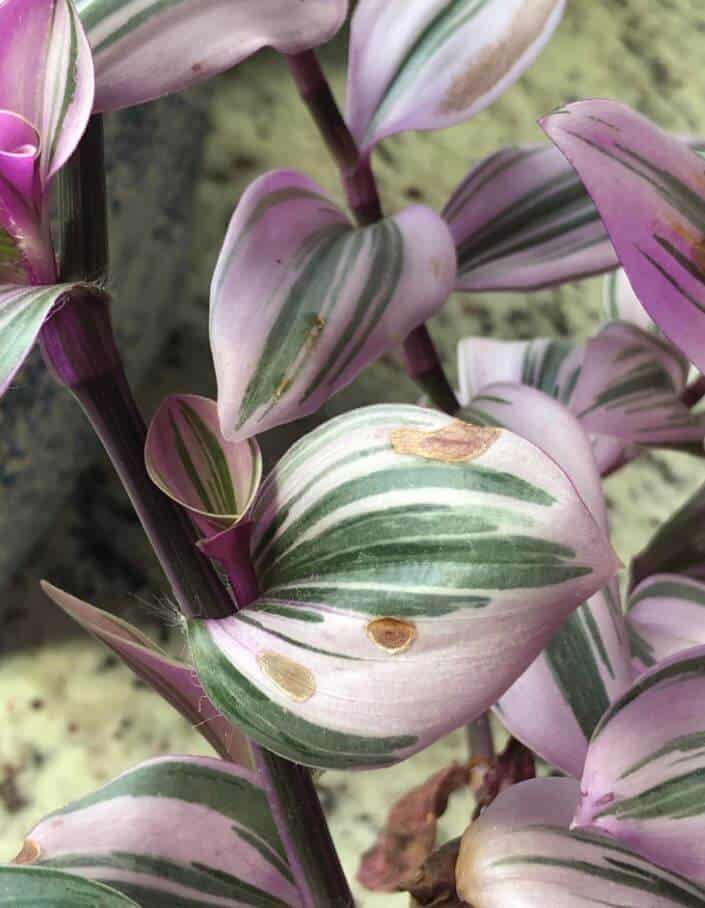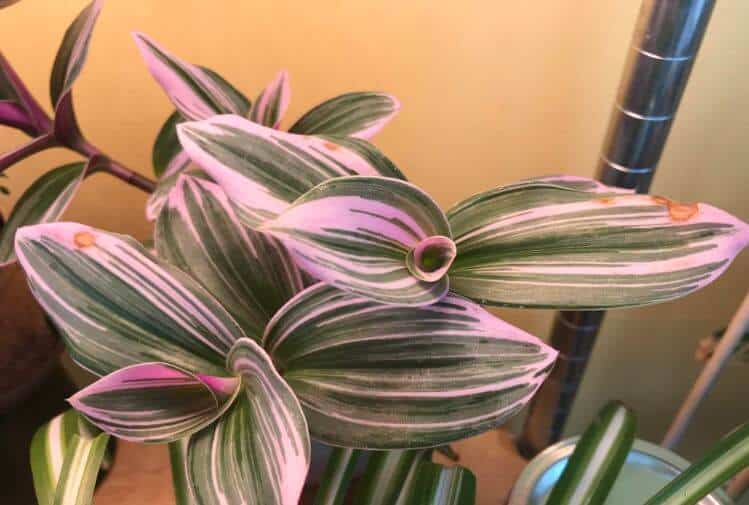Last Updated on October 3, 2023 by a Friendly Gardener
Brown spotting on Wandering Jew leaves is a common issue, but not there’s no need to worry as this condition is easy to fix. However, to repair or reverse this condition, you must identify the cause.
Botanically named Tradescantia, this plant is commonly called the Inch plant, the Wandering Dude plant, or the Wandering Jew plant. Brown spotting or brown leaves developing on a Tradescantia can be a source of frustration, but if you determine the cause, you can often resolve the issue relatively quickly. It doesn’t matter what variety of Tradescantia you have (blossfeldiana, pallida, zebrina, or other), brown spotting is common to all these plant varieties.
Why Are There Brown Spots on Wandering Jew Leaves?

Any plant parent of a Wandering Jew will occasionally encounter brown spots on leaves or leaves turning brown. Let’s consider the most probable causes of Wandering Jew brown spots on leaves.
Underwatering
A soil bed that does not retain sufficient moisture can cause Tradescantia plants to struggle. If the soil bed dries out entirely and remains dry for an extended period, foliage can fail, causing brown spots to appear or turn altogether brown and die.
What to do
Maintaining a moist soil bed will eliminate or reduce the risk of underwatering and overwatering. Avoid letting your plant’s soil dry out entirely. When the top inch or so of the soil bed feels dry, water your plant deeply, allowing excess water to drain. If you have doubts, consider using a moisture meter to measure soil moisture.
Improper Humidity

Wandering Jew plants prefer environments that have high levels of humidity. A lack of humidity is one of the principal reasons for foliage browning. This can be a real problem in colder climates during the winter season when the heat is turned on or during the summertime’s air conditioning.
What to do
Using a humidity monitor, verify the environmental humidity around your plant to verify if the room air is too dry. If so, move your plant to a room with greater humidity, like a bathroom, or introduce a space humidifier near your plant. A pebble tray can also be positioned beneath your plant’s container to increase humidity in the immediate vicinity of your Wandering Jew. Also, avoid placing your plant in new heating or air conditioning units, vents, and fireplaces.
Rot Diseases

Just as a lack of moisture in the soil or the air can cause brown spotting, overwatering can also do so. Excessive moisture can lead to both stem rot and root rot, and these infections will eventually damage and kill foliage. Often, the initial symptoms include yellowing and soft plant parts in soggy soil.
What to do
Rotting vines, leaves, or plants need to be removed. If your plant sits in soggy soil, it must be repotted in fresh soil in a clean, sterile pot. Affected roots also need to be trimmed off and disposed of.
Damaged Tradescantia Vines

Tradescantia vines are characteristically delicate. They can snap or break easily and are at risk for breakage when the plant is moved or disturbed. When Wandering Jew vines or stems are broken, damaged, or even kinked, the vines cannot transfer water and nutrients necessary for survival to the foliage.
What to do
To contrast damaged or kinked vines, prune Wandering Jew foliage that has brown spots patches or is turning brown. Use sterilized sharp gardening shears or scissors to remove damaged or rotting vines.
Scorching and Sunburn
When cultivated outside, your Tradescantia will thrive in a spot with partial shade. Indoors, your plant needs bright, indirect sunlight. If you have placed your plant in a location where it receives direct, intense sunlight, leaves will scorch or burn, causing them to develop brown spots and gradually turning them brown altogether. Sunburn is generally easily identifiable as the upper side of the leaf will be more affected.
What to do
Position your Tradescantia plant in a partially shaded spot. Avoid direct sunlight exposition. Consider using a growth light if your shady spot does not offer sufficient light for your plant to thrive.
High Environmental Temperatures
Wandering Jew plants do not respond well to temperatures above 85°F. The heat will cause brown spots or patches.
What to do
Place your plant where the temperature measures between 65° and 75° F.
Overfeeding

These plants are not heavy feeders, so fertilizing often or giving too much fertilizer can be toxic, causing leaves to develop brown spots. Overfertilization results in a buildup of salts in the soil bed. This soil condition will prevent the plant’s root system from absorbing adequate nutrients and water for general health and survival.
What to do
Use liquid fertilizers to feed your plant and dilute the recommended dosage. This will aid in preventing fertilizer burn. If you suspect fertilizer burn is the cause of brown spots, flush out your plant’s soil bed deeply and drain all excess water from the plant’s container.
Pest Infestations
Brown spots on Tradescantia can be symptomatic of a pest infestation. Insects known to attack Wandering Jew plants include:
- Aphids
- Scale
- Mealybugs
- Spider mites
- Whiteflies
- Thrips
These sap suckers can do significant damage to a plant. As some of these insects are brown and small, they may appear as brown spots on your plant, and as they steal nutrients, brown spots, and patches will appear.
What to do
Give your Tradescantia a monthly shower to prevent pest infestations. Treat your plant with insecticidal soap or Neem oil if one has already taken hold.
Natural Aging
Suppose the lower leaves on a Tradescantia vine are browning and appear to be the only leaves affected on the plant. In that case, brown spots may indicate old age, especially if you have eliminated other causes.
Another thing to consider is the variety of your Tradescantia plant. Some Tradescantia cultivars like the Tradescantia Tricolor, also called the ‘Purple Queen,’ have brown naturally on mature leaves and stems at the bottom of the plant’s vine.
Removing Leaves with Brown Spots on Wandering Jew Plants
You can prune off brown leaves and foliage with brown spots to keep your Tradescantia plant looking its best. Cut leaves off back to the leaf base and do so with a pair of gardening scissors. Do not just pinch them off because you may damage or break the delicate vines in the process.

